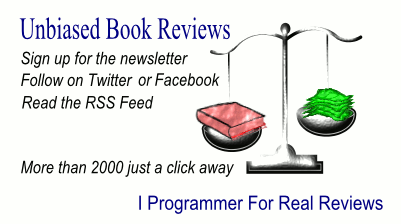| Pragmatic Guide to JavaScript |
Author: Christophe Porteneuve Author: Christophe Porteneuve This is a slim book (150 pages) and from its title you might expect it to cover the JavaScript language pure and simple. In fact it makes heavy use of libraries such as JQuery and particularly Prototype. However this isn't the biggest problem with this book.
It starts out reasonably enough with a look at "pure JavaScript" but it picks on just three cookbook style problems - dynamically selecting a method/property, code privacy the module pattern and using optional, variable and named arguments. These are interesting topics but why pick on these as the only topics included in this section? What makes them so core to JavaScript that they need to be included? I don't know the answer but I suspect that author just found them interesting. Unfortunately they don't have any general points to make about the language and they are so poorly explained that any opportunity that could be taken to turn them into something about how to use JavaScript is lost. The beginner is going to be mystified and anyone who has looked at using JavaScript in even slightly more advanced ways isn't going to be impressed. The next section is about the DOM, Events and Timers and again the problem is that it's is a very small selection of specialised topics that really don't hang together. Here we have a heavy use of libraries - JQuery and Prototype in particular. Again the explanations aren't good. Part III is all about UI tricks. This too makes use of libraries to get the work done. Topics include preloading images, creating tooltips, infinite scroll and viewport control. Again you have to wonder why these topics were chosen and again the explanations aren't good. As the book goes on the explanations become increasingly cut short with the code left to speak for itself. The problem here is that as the book goes on the code gets more complicated and it is likely to leave a beginner or a non-expert on any of the libraries wondering what is going on. Part IV is called Form Fu - which roughly translates to some cookbook recipes on forms and form handling. Most of these tips are either obvious or heavily dependent on using a library which does the job behind the scenes. Part V is on server side concerns, which roughly translates to using cookies and Ajax in general. The final part is a very odd collection of mashups i.e. working with other sites APIs - Flickr and Twitter. Again why these two isn't at all obvious and no general points are made. The book closes with a chapter called "Cheat Sheets" which is a two-page overview of JavaScript and a chapter on debugging. If the book had been called something like "JavaScript Cookbook" or "Random Recipes in JavaScript" then it might have been more on topic or better represented by its title. However viewed as a cookbook there just aren't enough recipes and there certainly aren't enough quality recipes. This said the biggest failing of the book is that it simply doesn't explain what is going on sufficiently - the average reader is often going to look at some code and simply not be able to work out how it does what it says. Overall the impression is that its pages are a collection of notes for the start of a book that could one day grow big enough for publication. Not recommended.
|
|||
| Last Updated ( Wednesday, 22 December 2010 ) |

